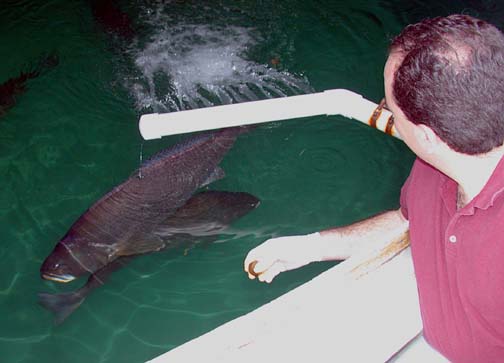
Totoaba Blessed Event
![]()
|
Totoaba researcher, Eduardo Palomar, feeds specially-formulated food "sausages" to four-foot long spawners at the Universidad Autónoma de Baja California in Ensenada, Mexico. |
SPECIAL MICROSCOPIC FEED REQUIRED FOR FRESH SPAWNED TOTOABA
By Gene Kira, April 8, 2002, as published in Western Outdoor News:
Last Friday, I drove my pickup from the U.S. border down to Ensenada, Baja California, Mexico, carrying 2,720,000,000,000,000 (that's 2.72 quadrillion) little green passengers given to me by Paul Curtis of the Hubbs-Sea World white seabass hatchery in Carlsbad, California.
If my little companions had been one-foot squares, they could have covered all the land area on earth about 1.5 times. But fortunately, they were quite a bit smaller than that.
In fact, they were so minuscule (less than 1/8,000th of an inch across), they all fit nicely into a couple of big cardboard boxes. After driving down the toll road, I delivered them to Conal David True of Ensenada's Universidad Autónoma de Baja California (UABC), where all 2.72 quadrillion of them will soon be eaten at a big party that will be the first of its kind anywhere in the world.
|
|
These little algae are called Nannochloropsis oculata, and they are an essential ingredient for a blessed event scheduled late next month, when Conal True's team of biologists become the first in the world to create an F2 generation of giant totoaba.
In biologist-talk, an F2 generation is the second generation of fish spawned from grandparents taken from the wild.
Seven years ago, Conal True's team went down to San Felipe and captured about a dozen of the endangered and protected giant totoaba for brood stock, using special federal permits. Ever since, he's been spawning those fish at his lab near the Marina Coral resort, and he's been releasing about 10,000 totoaba per year into the Sea of Cortez.
But this year, something "truly" special is going to happen. Some of the first baby fish produced, now grown to about four feet long, have become sexually mature, and Conal's team plans to spawn them, using the specialized technology that he's been developing, based on his master's degree work on white seabass at Hubbs-Sea World.
Although totoaba can be thought of as a gigantic (some records indicate up to 300 pounds) cousin of the white seabass, they have different spawning and dietetic requirements.
|
|
One of the main differences between totoaba and white seabass, apart from sheer size, is that female totoaba cannot be induced to spawn solely by manipulating day length and water temperature. They fill with eggs, but don't release them. To get a spawn, Conal and his biologists get into the tanks and give the females a shot of luteinizing hormone-releasing hormone, the same substance used in human infertility treatments, and the females release their eggs within a few hours.
According to Conal, it was originally thought that the males also needed a chemical jolt to release sperm, but that was incorrect. Once the females go into the action, the males know what to do, and they do it without help (or advice) from anyone.
In the wild, these magnificent fish can grow as heavy as marlin, and you get a feel for their massive size when the large brooders cruise slowly past the viewing ports. The sight of a four-foot long totoaba going into a mating dance (something like guppies, according to True) and releasing their eggs and sperm in captivity has to be the ultimate "X-rated" fish show, and I'm planning to be there, about the third week of May.
For that blessed event at Ensenada's UABC lab, my 2.72 quadrillion little algae, will be fed to about 2.4 billion bigger organisms called rotifers, which in turn will feed about 800,000 newly-hatched totoaba. With luck, about 10,000 of these will survive.
Ironically, none of these newborns will ever swim in the Sea of Cortez. As an F2 generation, they are no longer considered genetically pristine, and they can never be released into the wild, due to the risk of corrupting the natural gene pool. They will live out their lives as research subjects.
There is so much happening right now in Ensenada and Mexico City. Big political changes are about to decide the future of this incredible fish. I don't know why, but the story of the totoaba grabs me harder than any other, and I want to do all I can to help this magnificent animal return from the brink of extinction.
|
Technicians attend to rearing tanks at the totoaba lab near Ensenada's Marina Coral. Larger tanks outside the building hold the full-sized brood stock. |
(Related Ensenada articles and reports may be found at Mexfish.com's main Ensenada information page. See weekly fishing news, photos, and reports from the major sportfishing vacation areas of Mexico including the Ensenada area in "Mexico Fishing News.")
MEXICO FISHING INFO ENSENADA FISHING INFO "WEEKLY MEXICO FISHING NEWS" FISH PHOTO GALLERY

